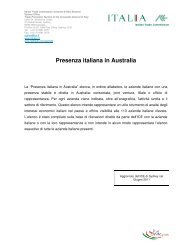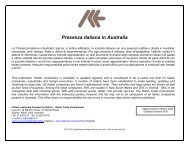Price Determination in the Australian Food Industry A Report
Price Determination in the Australian Food Industry A Report
Price Determination in the Australian Food Industry A Report
You also want an ePaper? Increase the reach of your titles
YUMPU automatically turns print PDFs into web optimized ePapers that Google loves.
Figure 4. Major drivers of prices and costs <strong>in</strong> agrifood products<br />
Our analysis has identified seven groups of factors and <strong>in</strong>fluences that generically affect food pric<strong>in</strong>g and costs across<br />
<strong>in</strong>dustries, regardless of <strong>the</strong> <strong>in</strong>dustry or product classification. The analysis of value cha<strong>in</strong>s <strong>in</strong> section 3 of this document will<br />
expla<strong>in</strong> <strong>the</strong> specific impact of <strong>the</strong>se items on each relevant food product sector.<br />
1. Farm production factors<br />
1.1 The volume and volatility of<br />
production.<br />
1.2 Seasonality of production – where<br />
highly seasonal production creates<br />
variation <strong>in</strong> available supply and<br />
prices through <strong>the</strong> cha<strong>in</strong>.<br />
1.3 The perishability or shelf life of <strong>the</strong><br />
product <strong>in</strong> raw material form<br />
strongly affects its value through<br />
<strong>the</strong> cha<strong>in</strong> and <strong>the</strong> negotiability of<br />
returns.<br />
2. Value-cha<strong>in</strong> <strong>in</strong>tegration<br />
2.1 The <strong>in</strong>creas<strong>in</strong>g vertical <strong>in</strong>tegration of<br />
activities through <strong>the</strong> cha<strong>in</strong>.<br />
2.2 Increas<strong>in</strong>g scale efficiency of process<strong>in</strong>g<br />
and manufactur<strong>in</strong>g facilities.<br />
2.3 Greater concentration of process<strong>in</strong>g,<br />
manufactur<strong>in</strong>g and brand ownership<br />
beyond <strong>the</strong> farmgate.<br />
2.4 The chang<strong>in</strong>g and diverse nature of<br />
competition and concentration at po<strong>in</strong>ts<br />
along <strong>the</strong> value cha<strong>in</strong>.<br />
3. The market<strong>in</strong>g approach<br />
3.1 Increas<strong>in</strong>g pressures on food manufacturers<br />
and marketers to provide differentiation <strong>in</strong><br />
products across a variety of factors.<br />
3.2 Globalisation of consumer brands.<br />
3.3 The <strong>in</strong>creas<strong>in</strong>g strength of convenience<br />
markets.<br />
3.4 A greater focus on specialisation and<br />
customisation of food products.<br />
3.5 Differentiation of f<strong>in</strong>ished product <strong>in</strong> terms<br />
of quality.<br />
Market<strong>in</strong>g<br />
Farm production Process<strong>in</strong>g Manufactur<strong>in</strong>g Wholesal<strong>in</strong>g Distribution Retail<br />
<strong>Food</strong> service<br />
4. Regulation and compliance<br />
4.1 The <strong>in</strong>creas<strong>in</strong>g costs of<br />
bus<strong>in</strong>ess compliance with<br />
regulation.<br />
4.2 The existence of barriers to<br />
greater value-cha<strong>in</strong><br />
profitability, generally <strong>in</strong> <strong>the</strong><br />
form of restrictions on<br />
consolidation.<br />
4.3 The <strong>in</strong>creas<strong>in</strong>g demands on<br />
value cha<strong>in</strong>s to meet ethical<br />
and product <strong>in</strong>tegrity demands,<br />
<strong>in</strong>clud<strong>in</strong>g environmental,<br />
welfare and food safety<br />
<strong>in</strong>tegrity.<br />
5. Trade impacts<br />
5.1 The extent to which primary<br />
and processed products are<br />
exported.<br />
5.2 The extent and tim<strong>in</strong>g<br />
(<strong>in</strong>clud<strong>in</strong>g <strong>in</strong> seasonal terms) of<br />
imported products <strong>in</strong> primary,<br />
processed or f<strong>in</strong>ished goods<br />
form.<br />
5.3 The <strong>in</strong>fluence of prevail<strong>in</strong>g<br />
world commodity prices on <strong>the</strong><br />
primary product, or <strong>in</strong> early<br />
stages of process<strong>in</strong>g.<br />
6. Technology and <strong>in</strong>novation<br />
6.1 The <strong>in</strong>creas<strong>in</strong>g capital <strong>in</strong>tensity<br />
<strong>in</strong> product transformation and<br />
manufacture.<br />
6.2 The differ<strong>in</strong>g degrees of<br />
transparency <strong>in</strong> market prices<br />
and costs.<br />
6.3 Greater <strong>in</strong>vestment <strong>in</strong><br />
<strong>in</strong>novation to diversify core<br />
products and extract value<br />
from co-products.<br />
7. Consumer and retail<br />
market dynamics<br />
7.1 The growth of <strong>the</strong> private<br />
label <strong>in</strong> food products.<br />
7.2 Greater demand for<br />
convenience and lifestyle<br />
solutions <strong>in</strong> meals and<br />
snacks.<br />
7.3 Greater concentration <strong>in</strong><br />
<strong>the</strong> retail sector – with<br />
<strong>in</strong>creas<strong>in</strong>g imposition of<br />
retail costs and marg<strong>in</strong><br />
pressure on suppliers.<br />
<strong>Price</strong> <strong>Determ<strong>in</strong>ation</strong> <strong>in</strong> <strong>the</strong> <strong>Australian</strong> <strong>Food</strong> <strong>Industry</strong> A <strong>Report</strong><br />
16<br />
MAJOR DRIVERS OF PRICES AND COSTS<br />
These are generic factors that have common effect across <strong>in</strong>dustries. Their specific relevance or<br />
o<strong>the</strong>rwise to specific products is discussed <strong>in</strong> section three.<br />
Farm production factors<br />
1.1 The volume and volatility of farm production – <strong>the</strong> year to year or season to season variation<br />
<strong>in</strong> total output from a primary production or supply <strong>in</strong>dustry.<br />
1.2 Seasonality of production with<strong>in</strong> a production year – highly seasonal production creates<br />
potential variation <strong>in</strong> <strong>the</strong> match<strong>in</strong>g of available supply and demand and may create<br />
fluctuations <strong>in</strong> prices through <strong>the</strong> cha<strong>in</strong>.<br />
1.3 The perishability or shelf life of <strong>the</strong> product – <strong>in</strong> raw material form, this strongly <strong>in</strong>fluences<br />
<strong>the</strong> time needed for <strong>the</strong> product to reach <strong>the</strong> market or next-stage process<strong>in</strong>g. This will<br />
<strong>in</strong>fluence <strong>the</strong> barga<strong>in</strong><strong>in</strong>g power of <strong>the</strong> producer and <strong>the</strong> value of <strong>the</strong> product downstream,<br />
depend<strong>in</strong>g on <strong>the</strong> extent to which supply matches available demand and whe<strong>the</strong>r <strong>the</strong> product<br />
is storable <strong>in</strong> processed or semi-processed form.<br />
Value-cha<strong>in</strong> <strong>in</strong>tegration<br />
2.1 Different degrees of vertical <strong>in</strong>tegration of activities through <strong>the</strong> cha<strong>in</strong> – <strong>the</strong> greater<br />
<strong>in</strong>cidence of vertical ownership or alliances through <strong>the</strong> cha<strong>in</strong> is reduc<strong>in</strong>g transaction costs,<br />
elim<strong>in</strong>at<strong>in</strong>g marg<strong>in</strong>s, <strong>in</strong>creas<strong>in</strong>g transparency to <strong>the</strong> <strong>in</strong>tegrator and provid<strong>in</strong>g for better<br />
match<strong>in</strong>g of demand and supply.







